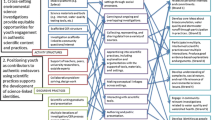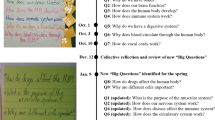Abstract
In this study we investigate how 5-year-old children in Brazil and their teachers collectively design science curriculum. More specifically, we develop an agency|structure dialectic as a framework to describe this collective praxis in which science curriculum may emerge as the result of children–teacher transactions rather than as a result of being predetermined and controlled by the latter. We draw on a cultural-historical approach and on the theory of structure and agency to analyze the events showing the complexity of the activity inside a classroom of very young children by science education standards. Data were collected in the context of a science unit in an early-childhood education program in Belo Horizonte. Our study suggests that (a) throughout the movement of agency|passivity || schema|resources one can observe participative thinking, a form of collective consciousness that arises in and from lived experience; (b) learning is a process in which a group is invested in searching for solutions while they create schemas and rearrange resources to evolve a new structure; and (c) the emergent curriculum is a powerful form of praxis that develops children’s participation from early childhood on.
Resumo
Neste estudo investigamos como crianças de cinco anos de idade e suas professoras produzem, coletivamente, um tópico de currículo em ciências. Mais especificamente, desenvolvemos uma revisão da dialética agency|structure como uma abordagem teórica para descrever essa práxis coletiva na qual um tópico do currículo de ciências emerge como resultado da transação professora-crianças mais do que de uma ação planejada anteriormente ou controlada pela professora. Baseamo-nos na abordagem histórico-cultural e na teoria da estrutura para analisar os eventos mostrando a complexidade da atividade em sala de aula de crianças ainda muito pequenas. Os dados foram coletados no contexto de uma unidade municipal de educação infantil em Belo Horizonte, Brasil, que se situa no Campus da Universidade Federal de Minas Gerais (UFMG). Esta unidade municipal tem como peculiaridade o atendimento de crianças provenientes de diferentes classes sociais, uma vez que se propõe a trabalhar com a comunidade interna à universidade (filhos de professores, estudantes e técnicos) assim como com a comunidade externa ao redor da universidade predominantemente composta pelas camadas populares. A diversidade cultural que distingue essa escola das demais abriu a possibilidade para as professoras experimentarem novas estratégias no desenvolvimento do currículo. Os eventos analisados neste artigo apresentam um momento singular em que a professora e as crianças categorizam algumas idéias sugeridas pelas últimas sobre o que elas gostariam de estudar, de forma a fazer emergir um projeto de investigação. Essa forma de trabalhar com o currículo na educação infantil requer um alto nível de participação de todo o grupo, uma vez que não se tem de antemão os conteúdos a serem trabalhados. Neste caso, o foco do trabalho da professora passa a ser escutar, interpretar e potencializar a demanda de conhecimento das crianças, abrindo espaço para suas diversas manifestações. Para analisar essa prática inovadora, desenvolvemos uma ferramenta teórica capaz de revelar a dinâmica da emergência do currículo. Por meio da dialética agency|passivity, schema|resources descrevemos e analisamos as ações dos participantes bem como os momentos de pausa e escuta do grupo de forma que as crianças e a professora pudessem criar esquemas possíveis de reconhecimento dos recursos disponíveis. Este estudo proporcionou os seguintes resultados. Em primeiro lugar, a ferramenta teórica desenvolvida foi potente o suficiente para revelar a dinâmica da emergência do currículo. Por meio do movimento de agency|passivity, schema|resources pode-se observar uma forma de tomada de consciência peculiar, denominada participative thinking, que surgiu da experiência vivida pelo grupo. Agindo e ao mesmo tempo abrindo-se para a escuta do outro, todos os participantes—a professora e as crianças—puderam manejar melhor os recursos presentes na atividade e construir novos esquemas que lhes habilitaram a categorizar as idéias trazidas pelas crianças. Em segundo lugar, pode-se constatar que a aprendizagem é um processo situado no contexto social no qual o grupo investe na procura de soluções que surgem como resultado da reorganização dos recursos disponíveis e dos esquemas recém criados. Nesse sentido, a atividade em curso faz surgir novas estruturas. Finalmente, nosso estudo trouxe evidências de que o currículo emergente é uma forma poderosa de práxis para desenvolver a participação das crianças desde a educação infantil.







Similar content being viewed by others
Notes
The classroom community is both context and product of the teacher’s and children’s participation.
Pseudonyms are used for the teacher and the children.
We use the term “ideal” in its cultural-historical activity theoretic sense, that is, as the dialectical complement to its material equivalent. The ideal|material dialectic maps a similar terrain as that invoked in saying that the material senses are at the source of sense making, i.e., having ideas about some aspect of the material world.
We understand this relationship by means of the analogy with light, which can be understood, depending on the situation, as a wave or as a particle. But neither wave character nor particle character can be reduced to the other that is, explained by means of the other perspective.
Consistent with materialist dialectics, we use the term moment to denote any structure that is smaller than the unit. As outlined, moments are not elements, because structures smaller than the unit cannot be understood independently because they are mutually constitutive and therefore express the unit only one-sidedly and incompletely. We use the term “instant” whenever we refer to time.
The second author (Wolff-Michael) became involved as an analyst. Already in a previous project, the two authors had collaborated in making sense of the data that Maria Inês had collected. As an outsider, he was in an ideal position to enact an analysis from a first-time through perspective. This perspective prevents readings and hearings in which the final outcomes of a study, inherently unknown to all participants at the time of data collection, are taken as a posteriori resources to explain why things have happened in the way they did.
The term transaction refers to the relationship between moments of activity, that is, structures that cannot be understood on their own.
Fifteen lessons (learning sessions) were videotaped between May and November of 2007. After the class, collaborative meetings amongst teachers, coordinators and Maria Inês were held, where they discussed what had happened in that day, as well as to prepare some possible ways to continue to explore the unit with the children. The episodes we analyze next were extracted from the first learning session that occurred in May 24, 2007.
There is an extensive literature on wait time suggesting that most teachers wait less than 1 s for students to respond (e.g., Tobin 1987). In this context, therefore, Denise has provided the children with a lot of time for responding.
References
Bakhtin, M. M. (1993). Toward a philosophy of the act. Austin: University of Texas Press.
Freire, P. (1987). Pedagogia do Oprimido [Pedagogy of opressed]. Rio de Janeiro, RJ: Paz e Terra. (original work published 1968).
Goulart, M. I. M., & Roth, W.-M. (2006). Margin|center: Toward a dialectic view of participation. Journal of Curriculum Studies, 38, 679–700. doi:10.1080/00220270600692936.
Holzkamp, K. (1992). On doing psychology critically. Theory & Psychology, 2, 193–204. doi:10.1177/0959354392022007.
Kirch, S. (2007). Re/production of science process skills and a scientific ethos in an early childhood classroom. Cultural Studies of Science Education, 2, 785–845. doi:10.1007/s11422-007-9072-y.
Leont’ev, A. N. (1978). Activity, consciousness and personality. Englewood Cliffs, NJ: Prentice Hall.
Quinteiro, J., & Carvalho, D. (2007). Participar, Brincar e aprender: exercitando os direitos da criança na escola [Participation, playing and learning: exercizing the children’s right in school]. Araraquara: Junqueira & Marin.
Rainio, A. P. (2007). Ghosts, bodyguards and fighting fillies: Manifestations of pupil agency in play pedagogy. International Journal of Human Activity Theory, 1, 149–160.
Rinaldi, C. (2006). In dialogue with Reggio Emilia: Listening, researching, and learning. New York: Routledge.
Roth, W.-M. (2007). Theorizing passivity. Cultural Studies of Science Education, 2, 1–8. doi:10.1007/s11422-006-9045-6.
Roth, W.-M. (2008). Knowing, participative thinking, emoting. Mind, Culture, and Activity, 15, 2–7.
Roth, W.-M., Lee, Y. J., & Hwang, S. (2008). Culturing conceptions: From first principles. Cultural Studies of Science Education, 3, 231–261. doi:10.1007/s11422-008-9092-2.
Roth, W.-M., McGinn, M. K., Woszczyna, M., & Boutonné, S. (1999). Differential participation during science conversations: The interaction of focal artifacts, social configurations, and physical arrangements. Journal of the Learning Sciences, 8, 293–347. doi:10.1207/s15327809jls0803&4_1.
Sewell, W. H. (1992). A theory of structure: Duality, agency, and transformation. American Journal of Sociology, 98, 1–29. doi:10.1086/229967.
Tobin, K. (1987). The role of wait time in higher cognitive level learning. Review of Educational Research, 57, 69–85.
Vygotsky, L. S. (1978). Mind in society: The development of higher psychological process. Cambridge, MA: Harvard University Press.
Vygotsky, L. S. (1986). Thought and language. Cambridge, MA: MIT Press.
Vygotsky, L. S. (1987). The collected works of L.S. Vygotsky (1896–1934) (Vol. 1). New York: Plenum.
Acknowledgments
This work was supported by a grant from the Capes Foundation (Coordenação de Aperfeiçoamento de Pessoal de Nivel Superior), Ministry of Education of Brazil, FAPEMIG (Fundação de Apoio à Pesquisa de Minas Gerais) and Pro-Reitoria de Pesquisa from Universidade Federal de Minas Gerais. Our thanks go to children and the teachers Danielle Rocha Rosa Campos and Cirleida Aparecida da Silva Alves for letting us participate in their classrooms. We also thank all the members of the GA (Articulation’s Group — Unidade Municipal de Educação Infantil Alaíde Lisboa) who assisted Maria Inês in the establishing the database and all the teachers who participate in the study group about teaching science in kindergarten (Brazil). We are grateful to the members of the Research Group Chat@Uvic (University of Victoria, Canada) for the collective session analysis (SungWon Hwang, Bruno Jayme, Gholamreza Emad, Pei-ling Hsu, Jean François Maheux, and Eduardo Sarquis Soares).
Author information
Authors and Affiliations
Corresponding author
Rights and permissions
About this article
Cite this article
Goulart, M.I.M., Roth, WM. Engaging young children in collective curriculum design. Cult Stud of Sci Educ 5, 533–562 (2010). https://doi.org/10.1007/s11422-009-9196-3
Received:
Accepted:
Published:
Issue Date:
DOI: https://doi.org/10.1007/s11422-009-9196-3




